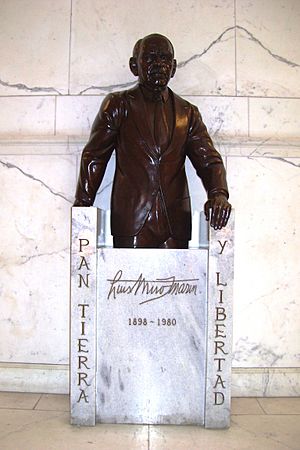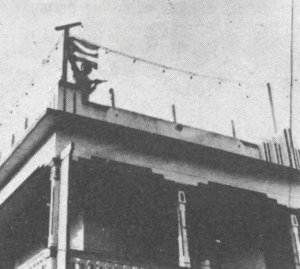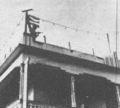Luis Muñoz Marín facts for kids
Quick facts for kids
Luis Muñoz Marin
|
|
|---|---|
 |
|
| Governor of Puerto Rico | |
| In office January 2, 1949 – January 2, 1965 |
|
| Preceded by | Jesús T. Piñero (appointed) |
| Succeeded by | Roberto Sánchez Vilella |
| President of the Puerto Rico Senate | |
| In office January 2, 1941 – January 2, 1949 |
|
| Preceded by | Rafael Martínez Nadal |
| Succeeded by | Samuel R. Quiñones |
| Member of the Puerto Rico Senate from the At-Large district | |
| In office January 2, 1941 – January 2, 1949 |
|
| In office January 2, 1965 – August, 1970 |
|
| Personal details | |
| Born |
José Luis Alberto Muñoz Marín
February 18, 1898 San Juan, Puerto Rico |
| Died | April 30, 1980 (aged 82) San Juan, Puerto Rico |
| Political party | Popular Democratic |
| Spouses | Muna Lee (1919–1938) Inés Mendoza (1946–1980) |
| Children | 4, including Victoria |
| Education | Georgetown University |
José Luis Alberto Muñoz Marín (born February 18, 1898 – died April 30, 1980) was an important Puerto Rican leader. He was a journalist, politician, and statesman. He became the first elected governor of Puerto Rico. Many people called him the "Architect of the Puerto Rico Commonwealth." This means he helped shape Puerto Rico's government.
In 1948, he was the first governor chosen by the people of Puerto Rico. His time as governor brought big changes. These changes helped Puerto Rico's economy, government, and society. Many leaders around the world praised his work. Muñoz Marín also played a key role in dealing with the Nationalist Party. This group wanted Puerto Rico to be fully independent.
Contents
Early Life and Education
Growing Up in Puerto Rico
Luis Muñoz Marín was born on February 18, 1898, in Old San Juan, Puerto Rico. His parents were Luis Muñoz Rivera and Amalia Marín Castilla. His father was a poet, a publisher, and a politician. He started two newspapers, El Diario and La Democracia. Just before Luis was born, his father helped Puerto Rico gain more self-rule from Spain. His father then became the Secretary of State for Puerto Rico.
In October 1898, the United States took control of Puerto Rico. This happened after Spain lost the Spanish–American War. Luis's father helped create a police force. But he did not like the military government set up by the U.S. He left his job in 1899. Later, he was elected to the House of Delegates of Puerto Rico.
When Luis was three years old, his family moved to Caguas. This was after his father's newspaper office was damaged. Later, they moved to New York City. There, Muñoz Marín learned English. His father started a new newspaper called Puerto Rico Herald. The family often traveled between Puerto Rico and New York. In 1904, his father's party, the Unionist Party, won the election. His father was then elected to the House of Delegates.
School Days
Muñoz Marín started school in Santurce, San Juan. Most classes were in English. This was a change made by the American government. Because he knew English, he moved to second grade quickly. In 1908, he went to a private school in San Juan. With his teacher's help, he learned many years of school material in just two years.
In 1910, his father became the Resident Commissioner of Puerto Rico. This job meant he represented Puerto Rico in the United States Congress. Muñoz Marín moved to Washington, D.C., with his father. In 1911, he started at Georgetown Preparatory School. But he did not like the strict rules. In 1915, his father enrolled him in law school at Georgetown University Law Center. But Muñoz Marín was more interested in becoming a poet.
In 1916, his father became very ill. Luis and his mother returned to Puerto Rico. His father passed away on November 15, 1916. Luis was eighteen years old.
Early Writings
After his father's death, Muñoz Marín returned to New York. He sold his law books. He published a book called Borrones, which had stories and a play. For a few months, he worked for Félix Córdova Dávila. This person took over his father's job in Congress.
Family Life
On July 1, 1919, Muñoz Marín married Muna Lee. She was an American writer. They had a daughter and a son together. They often lived apart and later separated in 1938.
Before his political campaigns in the late 1930s, Muñoz Marín met Inés Mendoza. She was a teacher. They believed that changing a country's language could make people unhappy. In 1940, they had a daughter named Victoria. Muñoz Marín and Inés Mendoza officially married in 1946. They had another daughter, Viviana.
Their daughter, Victoria Muñoz Mendoza, later became involved in Puerto Rican politics. In 1992, she was the first woman to run for governor of Puerto Rico.
Developing Political Ideas
In 1920, Muñoz Marín moved to Puerto Rico with his wife. He noticed that some landowners were paying poor farmers, called jíbaros, for their votes. He joined the Socialist Party. This decision surprised his family. He later became disappointed with the party. He then moved to New Jersey with his family.
In 1923, he returned to Puerto Rico alone. He was supposed to publish a book of his father's writings. But he spent the money he collected and left the island. Later, Antonio R. Barceló, a leader of the new Liberal Party, asked Muñoz Marín to work for La Democracia. This was the party's newspaper. After some disagreements, Muñoz Marín returned to New York. He wrote for American magazines like The American Mercury and The Nation.
In 1931, Muñoz Marín saw how unstable the U.S. economy was after the stock market crash. He decided to return to Puerto Rico. He found that a hurricane had destroyed many sugar crops. This left many jíbaros without jobs.
Political Career
Becoming a Senator
By the 1930s, Puerto Rico's political scene had changed. The Puerto Rican Nationalist Party was the main group asking for independence. Muñoz Marín met with their leader, Pedro Albizu Campos. He liked Albizu's ideas but had different ways of achieving change.
In 1932, Antonio R. Barceló formed a new independence movement. Muñoz Marín joined the Liberal Party. He led their newspaper, La Democracia. He decided to become a politician to bring about reforms. He spoke about providing more land, hospitals, food, and schools.
On March 13, 1932, Muñoz Marín was chosen to run for senator. He won enough votes to become a senator in the Puerto Rican Senate. He then arranged for Eleanor Roosevelt, the U.S. First Lady, to visit Puerto Rico. He wanted her to see the island's problems.
In August 1932, Muñoz Marín showed Eleanor Roosevelt poor areas that had been hit by a hurricane. When photos of her visit were published, it caused a stir. After her report, Franklin D. Roosevelt included Puerto Rico in the New Deal program. This program brought a lot of U.S. money to Puerto Rico. It helped build roads and homes. Muñoz Marín became very popular because of his role in this program.
In 1936, U.S. Senator Millard Tydings proposed a bill to give Puerto Rico independence. All Puerto Rican parties supported it, but Muñoz Marín did not. He believed it would harm the island's economy. Because of his opposition, he was removed from the Liberal Party.
Muñoz Marín then started a new group. In 1938, he helped create the Popular Democratic Party of Puerto Rico (PPD). This party promised to help the jíbaros. They promoted fair wages, food, water, and new industries. Muñoz Marín focused his campaigns in the rural areas. He told farmers not to sell their votes. The party's first meeting was very successful.
Leading the Senate
In 1940, the Popular Democratic Party won most seats in the Senate of Puerto Rico. This was thanks to Muñoz Marín's work in rural areas. He was elected as the fourth President of the Senate.
As Senate President, Muñoz Marín worked for the working class. With Governor Rexford Tugwell, he helped pass laws for farming, economic recovery, and new industries. This plan was called Operation Bootstrap. It aimed to change Puerto Rico from a farming economy to an industrial one. It also limited how much land large sugar companies could own.
Operation Bootstrap encouraged businesses to open factories in Puerto Rico. They were offered tax breaks and access to U.S. markets. This helped create many new jobs. In the 1950s, light industries like textiles grew. Later, heavier industries like oil refining developed. Farmers were trained for these new factory jobs. Muñoz Marín also started Operación Serenidad ("Operation Serenity"). This program promoted education and the arts.
World War II and New Leadership
During World War II, many Puerto Ricans joined the United States Army. This helped with the island's population issues. Muñoz Marín also pushed for building public housing. He created scholarships and loans for those not in the army. He also set up free public health clinics across Puerto Rico.
In 1944, the Popular Democratic Party won the election again. In 1947, the U.S. Congress allowed Puerto Ricans to elect their own governor. Muñoz Marín ran for the job and won. He became the first governor of Puerto Rico chosen by its people.
The Gag Law
In 1948, the Puerto Rican Senate passed Law 53, also known as the Gag Law. Muñoz Marín was in charge of the Senate at this time. This law limited the rights of independence and Nationalist groups. It allowed the arrest of suspected nationalists without a clear reason. This helped him control any challenges to his power.
The Ley de la Mordaza (Gag Law) was signed into law on June 10, 1948. It was similar to an anti-communist law in the U.S. Many saw it as a way to stop opposition to Muñoz Marín's party and the independence movement.
Under this law, it was illegal to own or show a Puerto Rican flag. It was also illegal to speak against the U.S. government or for Puerto Rican independence. Printing or selling materials that aimed to harm the government was also a crime. People found guilty could face ten years in prison or a large fine.
Dr. Leopoldo Figueroa, a member of another party, said the law was unfair. He argued it went against the U.S. Constitution's guarantee of freedom of speech. Muñoz Marín used this law to arrest many Puerto Ricans. This included people from other political parties.
Governor of Puerto Rico
Muñoz Marín became governor on January 2, 1949. He served for sixteen years, winning re-election in 1952, 1956, and 1960.
His party worked on creating an autonomous government. They agreed on a "Free Associated State" structure. In English, this was called a "Commonwealth." The goal was to give Puerto Rico more self-rule and its own constitution. The Constitution of Puerto Rico was approved by the people of Puerto Rico in 1952. The United States Congress also approved it.
The Nationalist Party of Puerto Rico wanted full independence. On October 30, 1950, some nationalists attacked the governor's mansion. They tried to assassinate Muñoz Marín. He had to hide under his desk. This was part of wider revolts that day. Muñoz Marín called in the Puerto Rican National Guard. He ordered police to arrest many nationalists, including Albizu Campos. His government used the Gag Law to arrest thousands of Puerto Ricans.
The new "Commonwealth" government officially began on July 25, 1952. Muñoz Marín worried that the new status might harm Puerto Rican culture or language. So, his government started promoting cultural activities. They founded the Pablo Casals Festival and the Puerto Rico Institute of Culture.
In the 1950s, many jíbaros moved to factories for work. Many also moved to New York City for industrial jobs. Muñoz Marín said he did not agree with this constant migration. He believed that a good life should also focus on farming, not just industry.
On December 6, 1962, U.S. President John F. Kennedy gave Muñoz Marín the Presidential Medal of Freedom. By 1964, Muñoz Marín had been governor for sixteen years. Some younger members of his party felt he should retire. They suggested limiting elected officials to two terms. Muñoz Marín's youngest daughter, Victoria, joined this group.
The day before his party was to choose candidates, Muñoz Marín announced he would not run again. He suggested Roberto Sánchez Vilella, his Secretary of State, as the next candidate. He told the crowd, "I am not your strength ... You are your own strength." Sánchez Vilella was then elected governor.
Later Years

After leaving the governor's office, Muñoz Marín continued to serve in the Puerto Rico Senate until 1970. In 1968, he had a disagreement with Governor Sánchez Vilella. Muñoz Marín decided not to support Sánchez's re-election.
Governor Sánchez ran under a new party. For the first time, Muñoz Marín's party, the PPD, lost the election. Luis A. Ferré became governor. This caused a strain in the friendship between Muñoz Marín and Sánchez Vilella.
Retirement and Passing
After leaving the Senate in 1970, Muñoz Marín moved to Italy for a while. He traveled around Europe. He returned to Puerto Rico two years later. He began writing his life story. He also supported Rafael Hernández Colón, the new leader of the Popular Democratic Party, for governor.
Later in his life, Muñoz Marín's health declined. On January 5, 1976, he had a severe stroke. This affected his ability to move, read, and speak. On April 30, 1980, he passed away at age 82. His funeral was a huge event across the island. Tens of thousands of people attended.
Legacy and Honors
- On November 13, 1961, John F. Kennedy honored Muñoz Marín at the White House. In 1963, he received the Presidential Medal of Freedom. This award recognized him as a "Poet, politician, public servant, patriot." It noted how he led his people to new dignity and purpose. He transformed Puerto Rico from a struggling land into a strong society.
- Muñoz Marín also received top honors from other countries. These included France, Panama, and Peru.
- He received honorary law degrees from Rutgers University and Harvard University. He gave many talks at Harvard about Puerto Rico's progress.
- Muñoz Marín was featured on the cover of TIME magazine twice, in 1949 and 1958. The articles called him "one of the most influential politicians in recent times."
- In 1985, Puerto Rico's largest international airport was renamed Luis Muñoz Marín International Airport in his honor.
- In 1990, the United States Postal Service issued a 5-cent stamp honoring Muñoz Marín. This was part of their Great Americans Series.
- In Cleveland, Ohio, the Luis Muñoz Marín Dual Language Academy is a school named after him.
- In Newark, New Jersey, the Luis Muñoz Marín School For Social Justice is also named in his honor.
- A 1974 oil painting of Muñoz Marín is at the National Portrait Gallery in Washington D.C.
- An etching of Muñoz Marín is on a five-cent red postage stamp. It was issued on February 18, 1990.
Images for kids
-
A sculpture of Muñoz Marín inside the Capitol of Puerto Rico.
See also
 In Spanish: Luis Muñoz Marín para niños
In Spanish: Luis Muñoz Marín para niños







